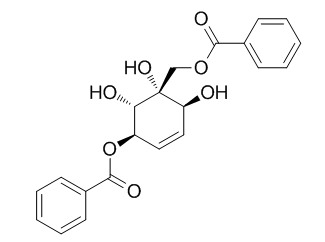Zeylenol
(-)-Zeylenol shows antifeedant activity. Zeylenol shows inhibitory activity toward the root growth of Lactuca sativa. Zeylenol probably possesses anti-inflammatory activity by inhibiting the synthesis or release of various inflammatory mediators and might be used to induce human breast cancer MDA-MB231 cell apoptosis.
Inquire / Order:
manager@chemfaces.com
Technical Inquiries:
service@chemfaces.com
Tel:
+86-27-84237783
Fax:
+86-27-84254680
Address:
1 Building, No. 83, CheCheng Rd., Wuhan Economic and Technological Development Zone, Wuhan, Hubei 430056, PRC
Providing storage is as stated on the product vial and the vial is kept tightly sealed, the product can be stored for up to
24 months(2-8C).
Wherever possible, you should prepare and use solutions on the same day. However, if you need to make up stock solutions in advance, we recommend that you store the solution as aliquots in tightly sealed vials at -20C. Generally, these will be useable for up to two weeks. Before use, and prior to opening the vial we recommend that you allow your product to equilibrate to room temperature for at least 1 hour.
Need more advice on solubility, usage and handling? Please email to: service@chemfaces.com
The packaging of the product may have turned upside down during transportation, resulting in the natural compounds adhering to the neck or cap of the vial. take the vial out of its packaging and gently shake to let the compounds fall to the bottom of the vial. for liquid products, centrifuge at 200-500 RPM to gather the liquid at the bottom of the vial. try to avoid loss or contamination during handling.
J Agric Food Chem.2023, 71(47):18510-18523.
Int J Mol Sci.2022, 23(11):6172.
J. Food Composition and Analysis2022, 114:104731
Phytomedicine.2015, 22(14):1262-8
BMC Complement Altern Med.2016, 16:213
J Korean Med Ophthalmol Otolaryngol Dermatol2023, 36(1):21-39.
J Med Food.2022, 25(3):272-280.
Biofactors.2018, 44(2):168-179
Cell Prolif.2021, 54(8):e13083.
Chemistry of plant raw materials2021, 1:pp 139-150
Related and Featured Products
Biosci Biotechnol Biochem. 2001 Jun;65(6):1395-8.
Four polyoxygenated cyclohexenes from the Chinese tree, Uvaria purpurea.[Pubmed:
11471741 ]
METHODS AND RESULTS:
Two novel polyoxygenated cyclohexenes, 6-methoxyZeylenol (3) and 2-acetoxyzeylenone (4), together with two known compounds, Zeylenol (1) and zeylenone (2), were isolated from the heartwood of the Chinese tree, Uvaria purpurea.
CONCLUSIONS:
Zeylenol (1) and zeylenone (2) both showed inhibitory activity toward the root growth of Lactuca sativa. Their structures were established by spectroscopic and chemical methods.
Scienceasia, 2013, 39(6):610-614.
Anti-inflammatory and anticancer activities of (-)-zeylenol from stems of Uvaria grandiflora.[Reference:
WebLink]
Uvaria grandiflora has stimulated rigorous phytochemical investigation aimed at determining chemical structures and biological activities. In recent years, many polyoxygenated cyclohexenes have been isolated from this genus. This study reports that Zeylenol isolated from the stems of U. grandiflora possess potential anti-inflammatory, anticancer, and caspase-3 activities.
METHODS AND RESULTS:
The structure of this compound was elucidated from spectroscopic analysis, particularly 2D NMR techniques. The anti-inflammatory effect and toxicity of Zeylenol were evaluated in animal models and compared to that of reference drugs. In addition, the cytotoxicity of the isolated compound against human breast cancer MDA-MB231 and hepatocellular carcinoma HepG2 cell lines were studied. The test (-)-Zeylenol at the dose of 1 mg/ear significantly inhibited oedema formation by 90%, 69%, 52%, and 52% after 15, 30, 60, and 120 min, respectively. Zeylenol was found to be toxic to both MDA-MB231 and HepG2 cells in a dose response manner with IC50 values of 54 +/- 10 and > 80 mu M, respectively. The compound induced MDA-MB231 cell apoptosis via caspase-3 activation.
CONCLUSIONS:
Zeylenol probably possesses anti-inflammatory activity by inhibiting the synthesis or release of various inflammatory mediators and might be used to induce human breast cancer MDA-MB231 cell apoptosis.
Phytochemistry. 2007 Jun;68(11):1579-86.
Polyoxygenated cyclohexane derivatives and other constituents from Kaempferia rotunda L.[Pubmed:
17493646]
METHODS AND RESULTS:
Methanol extracts of Kaempferia rotunda L. rhizomes yielded seven compounds including six polyoxygenated cyclohexane derivatives identified as (-)-6-acetylZeylenol (1), four acylated derivatives of 1-benzoyloxymethyl-1,6-epoxycyclohexan-2,3,4,5-tetrol (3-6), a Diels-Alder adduct of 3-benzoyl-1-benzoyloxymethylcyclohexa-4,6-dien-2,3-diol (7), and a triacylated derivative of salicin (9). The cyclohexane diepoxide, crotepoxide (8), was also obtained. Spectroscopic methods were used for structure determination.
CONCLUSIONS:
The methanol extract of the rhizomes of K. rotunda and (-)-2-acetyl-4-benzoyl-1-benzoyloxymethyl-1,6-epoxycyclohexan-2,3,4,5-tetrol (2-acetylrotepoxide B; 6), had antifeedant activity against larvae of Spodoptera littoralis. (-)-Zeylenol (2) also showed antifeedant activity, whereas (-)-6-acetylZeylenol (1) was inactive.



